| Home
> Adventures
> Beyond
Bali > Papua Adventures |
| |
| Papua
Adventures |
| |
 |
| |
West Papua forms the western half
of the large island widely known as New Guinea.
Administratively part of Indonesia, West Papua is
officially known as Irian Jaya.
West Papua is home to the most ethnologically primitive
cultures on Earth. No less than 25% of the world's
languages are spoken here and obviously you will
find a vast display of tribes and tribal customs.
These are people largely unaffected by the strictures
of the modern world as we know it; a race adapted
to daily life solely through their basic survival
elements. |
| |
| The Guides |
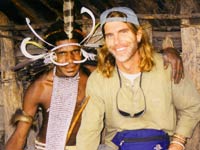 Papuans
live far away from the day to day realities of western
cultures and in that sense can seem very remote
and inaccessible to visitors. It is therefore vital
to have the right guide. Kelly Woolford, American
by birth but internationally bred, is a true explorer
and adventurer by trade. In his early forties, Kelly
has travelled and trekked the globe seeking out
the mysteries of different cultures and faraway
places with sensitivity and respect. He has received
warm welcomes from many people in many different
lands. Papuans
live far away from the day to day realities of western
cultures and in that sense can seem very remote
and inaccessible to visitors. It is therefore vital
to have the right guide. Kelly Woolford, American
by birth but internationally bred, is a true explorer
and adventurer by trade. In his early forties, Kelly
has travelled and trekked the globe seeking out
the mysteries of different cultures and faraway
places with sensitivity and respect. He has received
warm welcomes from many people in many different
lands. |
| |
| Travel Logistics and Bali |
 Your
guide, Kelly Woolford, resides in Bali which many
travellers find to be the most convenient and straightforward
entry-point into Indonesia. From Bali, there are
daily flights to Jayapura in West Papua via Makassar
on the island of Sulawesi. Therefore the usual travel
logistics for a West Papuan visit involve meeting
up in Bali. Kelly will arrange your internal flights
from Bali to and from Jayapura or elsewhere in Indonesia
if you wish. Your
guide, Kelly Woolford, resides in Bali which many
travellers find to be the most convenient and straightforward
entry-point into Indonesia. From Bali, there are
daily flights to Jayapura in West Papua via Makassar
on the island of Sulawesi. Therefore the usual travel
logistics for a West Papuan visit involve meeting
up in Bali. Kelly will arrange your internal flights
from Bali to and from Jayapura or elsewhere in Indonesia
if you wish. |
| |
| Jayapura and Lake Sentani |
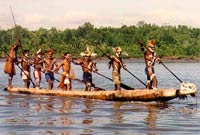 Lake
Sentani is a famous primitive arts centre. Bark
paintings, sago bowls and small-carved items are
amongst the local handicrafts found here. Kelly
is a private collector of primitive Papuan art and
therefore he has the depth of knowledge and connections
to ensure that you pay the right price and that
all items purchased are genuine. Lake
Sentani is a famous primitive arts centre. Bark
paintings, sago bowls and small-carved items are
amongst the local handicrafts found here. Kelly
is a private collector of primitive Papuan art and
therefore he has the depth of knowledge and connections
to ensure that you pay the right price and that
all items purchased are genuine.
The port city of Jayapura sits on the coast and
has a population of around 250,000 including many
people from other parts of the Indonesian archipelago.
It is not an unattractive city and you will find
museums, hotels, an assortment of restaurants, banks
and markets for shopping. From Jayapura it is easy
to take guided overnight treks to primitive villages
and it is a 45-minute flight to Wamena, the main
town of the famed Baliem Valley. |
| |
| The Baliem Valley |
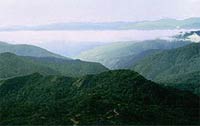 The
Baliem Valley was once dubbed Shangri La and it
is easy to see why. The Valley is incredibly lush
and fertile and is surrounded on all sides by towering
peaks of 2,500 to 3,000 metres. The fertility is
such that the valley has been farmed for 9,000 years
but it was only discovered by westerners in 1938!
There are three mains tribes inhabiting the Baliem
Valley: The Dani in the base, the Lani to the west
and the Yali in the south-east. Each tribe has a
distinct culture. One sure and interesting way to
distinguish between the tribes is from the Koteka,
or penis gourd, sported by the male members. The
men of each tribe tend to the growing of the gourds
with the three tribes each cultivating a different
style. The Dani use a long, thin Koteka, the Lani
sport a medium sized, wide cannon-like gourd, and
the Yali wear the longest of all. The
Baliem Valley was once dubbed Shangri La and it
is easy to see why. The Valley is incredibly lush
and fertile and is surrounded on all sides by towering
peaks of 2,500 to 3,000 metres. The fertility is
such that the valley has been farmed for 9,000 years
but it was only discovered by westerners in 1938!
There are three mains tribes inhabiting the Baliem
Valley: The Dani in the base, the Lani to the west
and the Yali in the south-east. Each tribe has a
distinct culture. One sure and interesting way to
distinguish between the tribes is from the Koteka,
or penis gourd, sported by the male members. The
men of each tribe tend to the growing of the gourds
with the three tribes each cultivating a different
style. The Dani use a long, thin Koteka, the Lani
sport a medium sized, wide cannon-like gourd, and
the Yali wear the longest of all. |
| |
| The Korowai and Kombai |
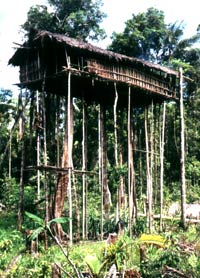 The
Korowai live in tree houses usually built between
six and 25 metres above ground but they can be as
high as 50 metres in times of tribal conflict. Stone
and bone tools are the standard here - surely one
of the last remaining cultures in the world which
use these instruments as a matter of course. Any
serious primitive art collector heavily prizes a
Korowai stone-axe. These people also make heavy
use of Flying Fox, Dog and Pig bones for body decoration.
They subsist by hunting and gathering in a similar
fashion to The Asmat Tribe. Here are a people usually
completely naked (maybe a leaf), fully immersed
in nature and with no apparent interest in anything
other than what they already are. The
Korowai live in tree houses usually built between
six and 25 metres above ground but they can be as
high as 50 metres in times of tribal conflict. Stone
and bone tools are the standard here - surely one
of the last remaining cultures in the world which
use these instruments as a matter of course. Any
serious primitive art collector heavily prizes a
Korowai stone-axe. These people also make heavy
use of Flying Fox, Dog and Pig bones for body decoration.
They subsist by hunting and gathering in a similar
fashion to The Asmat Tribe. Here are a people usually
completely naked (maybe a leaf), fully immersed
in nature and with no apparent interest in anything
other than what they already are. |
| |
| The Asmat |
 The
Asmat tribe resides in the tidal swamplands of West
Papua's south coast. They are renowned amongst tribal
art experts world wide as woodcarvers of the highest
order. They were previously notorious as head-hunters
and cannibals. The
Asmat tribe resides in the tidal swamplands of West
Papua's south coast. They are renowned amongst tribal
art experts world wide as woodcarvers of the highest
order. They were previously notorious as head-hunters
and cannibals.
The Asmat Wowipit (ood carver) has a truly spiritual
approach to carving and each piece made is imbued
with the spirit energy of their ancestors. An Asmat
carving can therefore be regarded as a bridge between
the material and spirit worlds. The Asmat believe
that their creator - FUMERAPITJS - carved their
ancestors from trees and gave them the blessing
of life, so from the very beginning the relationship
of carver to wood is totally sacred. |
| |
| Biak and Yapen Islands |
 Biak
is one of the better known areas of West Papua and
it formerly served as a major air-stopover on trans-pacific
flights from Indonesia. At that time there were
clearly plans to develop this pearl of an island
for tourism but that never really happened and the
stop-over flights ceased. That being said, a visit
to Biak, sitting off the north-west coast, is certainly
one of the easier options in West Papua. It is a
small island only 50 M across and averaging about
18 KM wide. Regular flights from Jayapura serve
the island. Biak
is one of the better known areas of West Papua and
it formerly served as a major air-stopover on trans-pacific
flights from Indonesia. At that time there were
clearly plans to develop this pearl of an island
for tourism but that never really happened and the
stop-over flights ceased. That being said, a visit
to Biak, sitting off the north-west coast, is certainly
one of the easier options in West Papua. It is a
small island only 50 M across and averaging about
18 KM wide. Regular flights from Jayapura serve
the island. |
| |
| Mamberamo River |
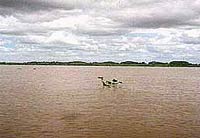 The
Mamberamo River is the Amazon of Papua. Weaving
its way through vast territories of virtually unexplored
terrain. Within it's watery reaches there live tribes,
who to this day remain almost completely un-contacted
by the outside world. The
Mamberamo River is the Amazon of Papua. Weaving
its way through vast territories of virtually unexplored
terrain. Within it's watery reaches there live tribes,
who to this day remain almost completely un-contacted
by the outside world. |
| |
| First Expedition |
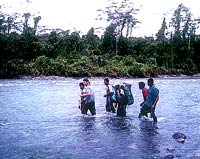 This
“first contact” trek is not just another
adventure travel tour, but a full-on exploratory
expedition. In this “first contact”
expedition we will be exploring one of the most
beautiful and pristine rainforests in the world.
We will be traveling into area where there are no
roads, air-fields or helicopter landing pads. Where
the challenges and treasures of total nature are
experienced. This
“first contact” trek is not just another
adventure travel tour, but a full-on exploratory
expedition. In this “first contact”
expedition we will be exploring one of the most
beautiful and pristine rainforests in the world.
We will be traveling into area where there are no
roads, air-fields or helicopter landing pads. Where
the challenges and treasures of total nature are
experienced.
In this manner, there is no describing what can
felt and realized on an expedition such as this.
This “first contact” expedition requires
extreme sensitivity and thus the exploratory party
will be limited to only four people. |
| |
| First Contact Summary |
 There
was one porter/guide who had spotted a man in the
forest several months before and this is where we
wanted to go. We set up camp along a small river.
Our guide told us that on the other side of the
river was another tribe's territory -- a territory
where none of our porters had ever visited even
though it is only a few days walk away from their
village. This tribe still uses bone and and stone
tools and has never seen a white skinned or Indonesian
person. This new tribe, Waira is very territorial
and outsiders are not welcome. If you want to see
them, you have to go into their territory because
they never leave the area. We proceded to make a
basecamp there, cutting down trees and making a
pondok (bush shelter) for our porters to sleep under. There
was one porter/guide who had spotted a man in the
forest several months before and this is where we
wanted to go. We set up camp along a small river.
Our guide told us that on the other side of the
river was another tribe's territory -- a territory
where none of our porters had ever visited even
though it is only a few days walk away from their
village. This tribe still uses bone and and stone
tools and has never seen a white skinned or Indonesian
person. This new tribe, Waira is very territorial
and outsiders are not welcome. If you want to see
them, you have to go into their territory because
they never leave the area. We proceded to make a
basecamp there, cutting down trees and making a
pondok (bush shelter) for our porters to sleep under. |
| |
| Flora and Fauna |
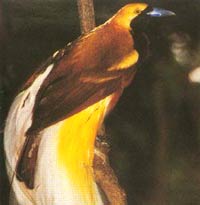 West
Papua is home to an amazingly diverse flora and
fauna. The immense variety is determined by the
sheer variety of ecosystems present: from shallow
coral reefs, through coastal swamps, altitudinally
differing rainforest and heigths rising to alpine
glaciers. West
Papua is home to an amazingly diverse flora and
fauna. The immense variety is determined by the
sheer variety of ecosystems present: from shallow
coral reefs, through coastal swamps, altitudinally
differing rainforest and heigths rising to alpine
glaciers.
Savannah Forest, dominated by Australasian Acacias
and Eucalypts, is found only in the south-eastern
corner of West Papua (Wasur National Park), Similar
Savannah occurs in the Port Moresby area of Papua
New Guinea. |
| |
| Travel Tips |
| When a client confirms a booking,
a full, detailed list of what to bring and travel
tips will be forwarded and this list will be tailored
to the specific trek which has been booked. However,
the following section can be used as a general guide.
|
| • |
Passport must be valid for at
least six months after your date of DEPARTURE
from Indonesia |
| • |
Four additional passport photographs and
two photocopies of your passport will be needed
for the special permits as soon as we arrive
in West Papua |
| • |
Credit cards are rarely accepted in West
Papua so please plan appropriately |
| • |
Recommended inoculations (see your local
travel clinic) and malaria prophylaxis |
|
| |
| Trips Schedule |
Korowai - Tree House People
"New Korowai Territory" |
19 Days, February
2006 |
| Waira Tribe - "Second Contact" |
16 Days, March 2006 |
| Korowai - Tree House People and Asmat Tour |
18 Days, April 200 |
Korowai - Tree House People
" New
Korowai Territory" |
19 Days, May 2006 |
| Korowai - Tree House People and Asmat Tour |
18 Days, July 2006 |
Expedition - Waropen/Mamberamo
"Land
of The Unexpected" |
20 Days, August 2006 |
| "First Contact " - Expedition |
17 Days, October 2006 |
| Kombai - Tree House People |
7 Days, November
2006 |
|
| |
|
| |
Email : [email protected]
website : www.
papua-adventures.com |
| |
